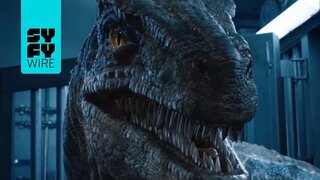Create a free profile to get unlimited access to exclusive videos, sweepstakes, and more!
Meet Rexy's Big, Bad Tyrannosaur Cousin, Tyrannosaurus mcraeensi
T. mcraeensi predated T. rex by 7 million years, but would have rivaled it in a fight.
Tyrannosaurus rex is arguably the most famous dinosaur of all time. It has been the subject of considerable scientific research, and the focus of lunchboxes and bedsheets for generations. In 1993, T. rex had a starring role in a little movie called Jurassic Park. Over the course of the Jurassic Park/World series, Rexy has swept in at the last moment to save the day more than once, most recently in Jurassic World Dominion, streaming now on Peacock.
Given the level of scrutiny and adoration levied upon T. rex, you’d think we’d have a pretty good handle on what they are and how they came to be. However, a recent discovery identified a previously unknown ancestor.
Tyrannosaurus mcraeensi, Tyrannosaurus rex’s Older Cousin, Ruled Ancient New Mexico
A new species of Tyrannosaur has been identified from a specimen held in a New Mexico museum collection. It was first uncovered in 1983 at New Mexico’s Hall Lake Formation. Initial analysis of the specimen identified it as T. rex and it has been on display under that moniker ever since. At the time, some anomalies in the specimen were discarded as ordinary variation, but new knowledge and a new analysis tell a different story.
RELATED: Dinosaur Census! Scientists Estimate 1.7 Billion T. Rexes Ever Lived
“They found a couple of dinosaurs out there, a horned dinosaur and a tyrannosaur. The bones were big, the jaw was really big, so they assumed it was T. rex. The horned dinosaur, they assumed was maybe Torosaurus,” Nick Longrich, a paleontologist at the University of Bath, told SYFY WIRE. “Torosaurus and T. rex were both Late Maastrichtian (the latest period of the Late Cretaceous), so the locality was assumed to be Late Maastrichtian on that basis.”
Longrich and the co-authors of a new study describing the animal, published in the journal Scientific Reports, began with redescribing the Ceratopsian previously identified as Torosaurus. Pretty soon, they realized it wasn’t Torosaurus at all, but something more primitive. That lined up with radiometric dates which placed the Ceratopsian and Tyrannosaur earlier than the Maastrichtian. T. rex only lived during the last few million years of the Cretaceous leading up to the asteroid and the K-Pg extinction event, but this Tyrannosaur predated that by 6 or 7 million years. It’s not uncommon for dating to be off by a million years, Longrich says, but it’s unlikely to be off by several million years.
With the date called into question, the team went back to the Tyrannosaur fossil to give it another once-over. Suddenly, all of those morphological differences which were previously considered normal T. rex variation, were cast in a different light. Every bone they looked at was different from T. rex in subtle ways, suggesting a more primitive variation on the Tyrannosaur form. It became clear they were looking at something different, something which predated the emergence of T. rex in Laramidia, a prehistoric continent stretching from modern-day Alaska to Mexico.
While the newly dubbed Tyrannosaurus mcraeensis and T. rex were similar in stature, they are different in noticeable ways. “Maybe not in the way that a raccoon and a bear are different, but the way that a crow and a raven are different. The same way you can tell apart a golden eagle and a bald eagle or a lion and a tiger, you could tell these things apart. The jaw shape and skull shape would be a bit different,” Longrich said. “This thing has teeth that are not as fat or as pointy and spike-like; they are a bit more blade-like. All of these things are more primitive, it’s not quite as advanced. It’s got a few million years from the T. rex end point.”
The fact that T. mcraeensis is about the same size as T. rex is surprising. The general consensus is that animals start small and become larger over time. Finding such a large Tyrannosaur so early was unexpected and forces us to reimagine what Tyrannosaur evolution looked like in terms of scaling. The find also forced another look at the geographical spread of Tyrannosaurs over time.
RELATED: So apparently a baby tyrannosaurs was deceptively adorable, but still deadly
Prior to this find, the closest known relative of T. rex was Tarbosaurus, found in Mongolia and China. The running hypothesis was that the Tyrannosaur group emerged in Asia and later migrated across a land bridge to what is now North America. The new finding suggests a T. rex origin story closer to home. It’s also possible that the group moved back and forth across continents throughout their history.
“Did these guys cross the land bridge, go to Asia, evolve there, and come back? Some dinosaurs do this. You’ll see duckbills with relatives on both sides of the Pacific. In this case, we have something closer to T. rex in its anatomy and size in North America, so it kind of neatly fills that gap,” Longrich said. “And there is still a trend toward larger size over time, it’s just that the trend ramps up faster and hits that plateau faster than we thought.”
It’s likely there are an unknown number of discoveries like this tucked away in museum collections all over the world, just waiting to be reanalyzed. Tyrannosaurs are one of the most studied dinosaur groups with a large number of specimens recovered and there is still so much we don’t know.
Catch T. rex (or is it T. mcraeensis?) in Jurassic World Dominion, streaming now on Peacock.
































